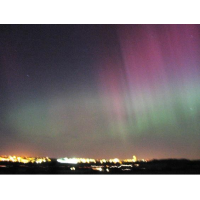Northern Lights above Lancaster

During a large geomagnetic storm on 21st January 2005, the aurora borealis appeared in the sky over Lancaster University.
Just left of centre, beneath the red and green glows of the aurora, can be seen the green and white glow of InfoLab21.
The “Northern lights”, or aurora borealis, are caused by charged particles colliding with the gas of the Earth’s atmosphere at heights of 100 km or greater. These particles originate in the Sun and travel through space as the solar wind, eventually becoming trapped in the Earth’s magnetic field (the Magnetosphere).
The progress of geomagnetic storms can be monitored using devices known as magnetometers, sensitive instruments for measuring the Earth's magnetic field.
Lancaster University's Department of Communication Systems – lead by Professor Farideh Honary - operates the UK Sub-Auroral Magnetometer Network (SAMNET) an array of magnetometers across the UK and northern Europe.
The SAMNET array is an important tool for studying the physical processes involved in these Sun-Earth interactions. It is funded by the Particle Physics and Astronomy Research Council (PPARC) as one of the UK Solar Terrestrial Physics (STP) National Facilities.
The data from the magnetometer is processed as it is recorded and used to show the current activity level on a web page (http://www.dcs.lancs.ac.uk/iono/aurorawatch).
Interested individuals can sign up to the AuroraWatch scheme to receive alerts when the activity is high when there is a chance that aurora may be seen. In the region of a dozen alerts are issued per year (depending on the activity of the Sun) and at the time or writing AuroraWatch has 18604 subscribers. Please contact Prof. Farideh Honary for further information.